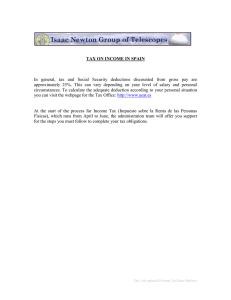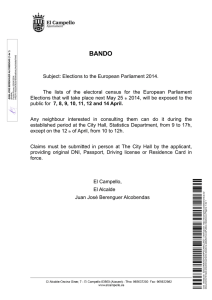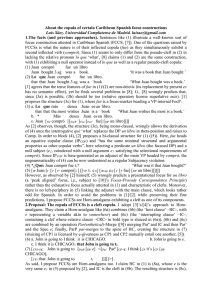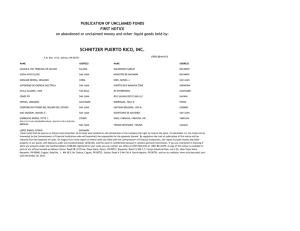Word Order and Information Structure in Spanish Montserrat
Anuncio
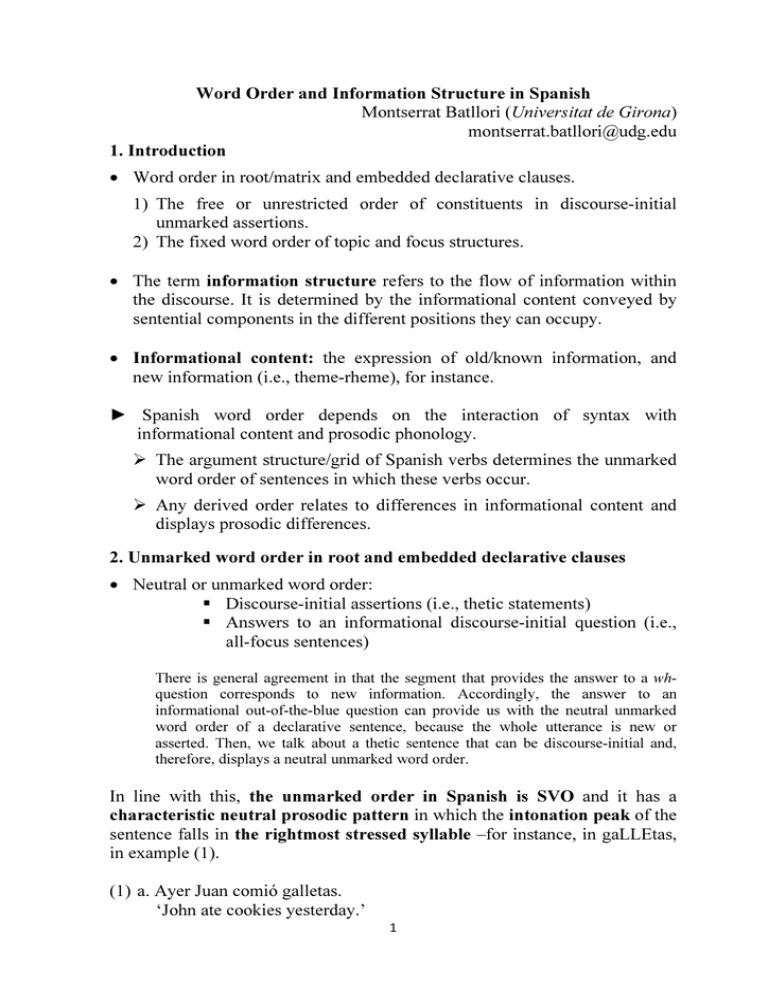
Word Order and Information Structure in Spanish Montserrat Batllori (Universitat de Girona) montserrat.batllori@udg.edu 1. Introduction • Word order in root/matrix and embedded declarative clauses. 1) The free or unrestricted order of constituents in discourse-initial unmarked assertions. 2) The fixed word order of topic and focus structures. • The term information structure refers to the flow of information within the discourse. It is determined by the informational content conveyed by sentential components in the different positions they can occupy. • Informational content: the expression of old/known information, and new information (i.e., theme-rheme), for instance. ► Spanish word order depends on the interaction of syntax with informational content and prosodic phonology. The argument structure/grid of Spanish verbs determines the unmarked word order of sentences in which these verbs occur. Any derived order relates to differences in informational content and displays prosodic differences. 2. Unmarked word order in root and embedded declarative clauses • Neutral or unmarked word order: Discourse-initial assertions (i.e., thetic statements) Answers to an informational discourse-initial question (i.e., all-focus sentences) There is general agreement in that the segment that provides the answer to a whquestion corresponds to new information. Accordingly, the answer to an informational out-of-the-blue question can provide us with the neutral unmarked word order of a declarative sentence, because the whole utterance is new or asserted. Then, we talk about a thetic sentence that can be discourse-initial and, therefore, displays a neutral unmarked word order. In line with this, the unmarked order in Spanish is SVO and it has a characteristic neutral prosodic pattern in which the intonation peak of the sentence falls in the rightmost stressed syllable –for instance, in gaLLEtas, in example (1). (1) a. Ayer Juan comió galletas. ‘John ate cookies yesterday.’ 1 b. ¿Qué ocurrió ayer? [New Info Juan comió galletas] ‘What happened yesterday? John ate cookies.’ 2.1. Informational content of Spanish SVO statements and the role of prosodic phonology. (2) a. ¿Qué hizo Juan? Juan [New Info comió galletas] ‘What did John do? John ate cookies.’ b. ¿Qué comió Juan? Juan comió [New Info galletas] ‘What did John eat? John ate cookies.’ (3) a. ¿Quién comió galletas? [New Info Juan] comió galletas. ‘Who ate cookies? John ate cookies.’ b. ¿Qué hizo Juan con las galletas? Juan [New Info se comió] las galletas. ‘What did John do with the cookies? John ate the cookies.” • Up to this point, we can state that SVO is the basic and unmarked word order in Spanish, and that any marked interpretation is directly related to differences in discourse informational content and prosodic properties. 2.2. Syntax and information structure distribution in declarative matrix clauses NOTICE: On the one hand: [Old/known Information subject] verb [New Information object] Known information is always referential→ Subjects must be referential. New information doesn’t have to be referential→ Objects can be referential and non-referential. On the other hand: The syntactic properties of verbs (and in particular their argument structure) can also impose certain conditions on the word order of some Spanish sentences. VS can be the unmarked order, and SV, a derived focal order. TRANSITIVE VERBS (SUBJECT = AGENT) (4) a. [Theme Los niños] comen [Rheme galletas] b. #Comen los niños galletas…1 1 It would be OK in the following discursive context: En estas fiestas de cumpleaños siempre pasa lo mismo. Comen los niños galletas hasta no poder más y luego resulta que les duele la barriga ‘In these birthday parties it is always the same. Children eat their fill of cookies and then they have a bellyache’. 2 c. *Niños comen galletas. d. *Comen niños galletas. e. *Comen galletas niños. ‘(The) Children eat cookies’ TRANSITIVE VERBS (SUBJECT = CAUSE) (5) a. El viento cerró la puerta. b. #Cerró el viento la puerta…2 c. *Viento cerró la puerta. d. *Cerró viento la puerta. e. *Vientos cerraron la puerta. f. *Cerraron vientos la puerta. ‘The wind closed the door’ UNERGATIVE INTRANSITIVE VERBS (SUBJECT = AGENT) (6) a. Los niños ríen porque les apetece (/voluntariamente) b. #Ríen los niños… c. *Niños ríen d. *Ríen niños porque les apetece (/voluntariamente) e. *NIÑOS ríen, y no señores. f. Con estas películas ríen [niños y mayores] (=‘young & old’) ‘(The/Some) Children laugh (because they feel like doing it /willingly)’ UNACCUSATIVE VERBS (SUBJECT = PATIENT/THEME) (7) a. La luz entraba por la persiana. (unmarked order) b. Entraba la luz por la persiana. c. Entraba luz por la persiana. (unmarked oder) d. *Luz entraba por la persiana. e. LUZ entraba por la persiana, y no humo. ‘(The) Light was coming in through the blind.’ (8) a. El agua sale por debajo de la lavadora. (unmarked order) b. Sale el agua por debajo de la lavadora. c. Sale agua por debajo de la lavadora. (unmarked order) d. *Agua sale por debajo de la lavadora. e. AGUA sale por debajo de la lavadora, y no jabón. ‘(The) Water is coming out from under the washing machine.’ (9) a. Los trenes llegan cada mañana a las 9:00. b. Llegan los trenes cada mañana a las 9:00. 2 (unmarked order) Entramos en una habitación lúgubre, pero todo el mundo se reía. De pronto, cerró el viento la puerta y todos empezamos a gritar ‘We went into a very gloomy room, but everybody was laughing. Suddenly, the wind closed the door and all of us started screaming’. 3 c. Llegan trenes cada mañana a las 9:00. (unmarked order) d. *Trenes llegan cada mañana a las 9:00. e. TRENES llegan cada mañana a las 9:00, y no autobuses. ‘(The) Trains arrive at 9:00 every morning’ LOCATIVE VERBS (10)a. Los lobos viven/están en aquellas montañas. b. #Viven los lobos en aquellas montañas. c. *Lobos viven/están en aquellas montañas. ‘Wolves live in those mountains’ EXISTENTIAL VERBS (SUBJECT = THEME) (11)a. Viven/hay lobos en aquellas montañas. b. *Viven/hay los lobos en aquellas montañas. c. *Lobos viven/hay en aquellas montañas. d. LOBOS viven/hay en aquellas montañas, y no osos. ‘There are wolves in those mountains.’ SE-PASSIVES (UNACCUSATIVE STRUCTURES – ACTIVE DO → PASSIVE S) (12)a. La fruta de temporada ya se vende b. Ya se vende la fruta de temporada. c. *Fruta de temporada ya se vende. d. Ya se vende fruta de temporada. e. FRUTA DE TEMPORADA ya se vende, y no fruta tropical. ‘Seasonal fruit is already on sale.’ PSYCHOLOGICAL VERBS ([DATIVE EXPERIENCER] + VERB + [NOMINATIVE THEME]) (13)a. A mí me gusta el café (unmarked order) b. A mí el café me gusta (marked order) c. EL CAFÉ, me gusta a mí, y no el té. d. *A mí me gusta café e. *A mí café me gusta f. *CAFÉ me gusta a mí. ‘I like coffee’ 3. The word order of topic and focus constructions 3.1.Topic structures (14) ¿Quién se comió la manzana? [TOPIC La manzana] se la comió Juan. who CL ate the apple the apple CL it ate John (15)a. A María, la vi ayer. to Mary her saw yesterday 4 b. A la facultad, Ø fui ayer por la mañana. to the faculty went yesteday morning c. *A la facultad, fui allí ayer por la mañana. to the faculty went there yesteday morning d. A la Maria, la vaig veure ahir. [Catalan] to Mary her AUXPAST see yesterday e. A la facultat, hi vaig anar ahir al matí. [Catalan] to the faculty CLLOCATIVE AUXPAST go yesteday morning ► Three ways of expressing topicalization in Spanish. Hanging Topic Left Dislocation (HTLD) Clitic Left Dislocation (CLLD) Clitic Right Dislocation (CLRD) [=(16a)] [=(16b)] [=(16c)] (16)a. Hablando de María, recuerdo ahora que dejé el libro en su coche. ‘Talking about Mary, now I remember that I left the book in her car’ b. A María, la vi ayer. ‘Mary, I saw her yesterday’ c. La vi ayer, a María. 3.1.1. Hanging topic left dislocations Hanging topics can: • introduce a new discursive issue of which we already know something. • shift the subject of the previous discourse by changing the matter of conversation. They are coreferent with one of the constituents of the main clause that is generally a DP. That is, • a proper noun, • a pronoun, • or a DP with a part to whole relationship. Characterisation – see Bosque & Gutiérrez-Rexach (2009) Olarrea (2014): i. Their phrasal type: the left dislocated element can only be a DP. ii. The properties of the resumptive element: it can be either a phrase or a pronoun. iii. The type of constituent that can precede them: they can be preceded by topicalizing expressions such as en cuanto a ‘as for’, respecto a 5 ‘with regard to’, en lo referente a ‘with reference to’, hablando de ‘talking about’, etc. iv. The possibility of embedding them: they cannot be embedded and must occur in sentence initial position. v. The ‘connectivity’ between the displaced and the resumptive element: the dislocated element and its correferent in the sentence don’t have to agree in case, gender and number. vi. Their recursive properties: there can be more than one constituent dislocated, but they must be coordinated. (17)a. Juan, no me acuerdo de él. ‘John, I don’t remember him’ b. *En Juan no es posible confiar en él. in John not is posible trust in him c. En cuanto a Juan, no me acuerdo de sus coches. ‘As for John, I don’t remember his cars’ d. *Te he dicho que, en cuanto a Juan, ayer me encontré con él. to-you have told that, as for to John yesterday CL met with him e. Respecto al ordenador, yo odio esas máquinas infernales. ‘Regarding the computer, I hate these evil machines’ f. En cuanto al dictador y (respecto) al pueblo, este repudia a aquel. ‘As for the dictator and (as for) the people, the former hates the latter’ g. *Juan, el libro, él no lo ha comprador. John the book he not it has bought 3.1.2. Clitic left dislocations (18) Al niño no lo he visto To-the child not him have seen They could be considered sentence topics as opposed to hanging topics, that would be discourse topics. Characterisation – see Bosque & Gutiérrez Rexach (2009) Olarrea (2014): i. Their phrasal type: any phrasal type can be dislocated (DP, PP, AdjP, etc.) ii. The properties of the resumptive element: it can only be a clitic or a coreferent empty pronominal (i.e., Ø) iii. The type of constituent that can precede them: they cannot be preceded by topicalizing expressions. iv. The possibility of embedding them: They can be embedded. 6 v. The ‘connectivity’ between the displaced and the resumptive element: the dislocated element and its correferent in the sentence must agree in case, gender and number. vi. Their recursive properties: there can be more than one constituent dislocated. (19)a. A Juan lo vi ayer. to John him saw yesterday b. En Madrid estuvimos Ø la semana pasada. [Spanish] in Madrid we-were the week last c. A Madrid hi vam ser la setmana passada. [Catalan] in Madrid there we-AUX be the week last d. Listo, Juan lo es mucho. clever John it is a-lot e. Que vinieran, María no lo dijo. that they-came Mary not it said f. *A Juan a él vio ayer. to John to him saw yesterday g. *En cuanto a en Madrid estuvimos la semana pasada. as for to in Madrid we-were the week last h. Dijo que a Juan lo vio ayer. said that to John him saw yesterday i. *A Juan les compró un libro ayer. to John to-them bought a book yesterday j. *Al ordenador, los odio. to-the computer, them hate k. Ese libro a Pedro no se lo dio nadie. this book to Peter not to-him it gave anybody 3.1.3. Clitic right dislocations These structures display more or less the same properties as CLLD. Differences between CLRD and CLLD – see Bosque & Gutiérrez Rexach (2009) Olarrea (2014). i. Most people wouldn’t write CLRD. It is an oral construction. ii. The dislocated constituent appears in the right periphery. iii. There is a sharp intonational break between the sentence and the dislocated element (orthographically marked by a comma). In fact, it has its own intonational phrase contour (like HTLDs). 7 (20)a. lo vi ayer, a Juan. him saw yesterday to John b. Estuvimos Ø la semana pasada, en Madrid. [Spanish] we-were the week last in Madrid c. hi vam ser la setmana passada, a Madrid. [Catalan] there we-AUX be the week last in Madrid d. Juan lo es, muy listo. John it is very clever e. María no lo dijo, que vinieran. Mary not it said that they-came f. * a él vio ayer, a Juan. to him saw yesterday to John g. * Estuvimos la semana pasada, en cuanto a en Madrid. we-were the week last as for to in Madrid h. Dijo que lo vio ayer, a Juan. said that him saw yesterday to John i. *les compró un libro ayer, a Juan. to-them bought a book yesterday to John j. *los odio, al ordenador. them hate, to-the computer k. no se lo dio nadie, ese libro, a Pedro. not to-him it gave anybody this book to Peter 3.2. Focus structures Focalization is related to the expression of new information. New information can be conveyed by altering the unmarked word order of utterances, by emphasizing phrases in situ or by placing them in the left periphery of the sentence (i.e., focus fronting). 3.2.1. Changes in word order and focus in situ In declarative sentence constituents may be reordered so as to express new information in a marked way. These statements cannot be uttered discourse-initially. They are discourse linked and involve known information = [+ marked] word orders. (21) a. ¿Quién compró el periódico? Compró el periódico [FJuan] b. ¿Quién compró el periódico todos los días? Compró el periódico todos los días [FJuan] ‘Who bought the newspaper (every day)? John did’ c. ¿Qué compró Juan todos los días? Compró Juan todos los días [Fel periódico] 8 d. ¿Qué compró Juan todos los días? Todos los días compró Juan [Fel periódico] ‘What did John buy (every day)? John bought the newspaper’ Emphasis in situ = focused in its basic position. There cannot be more than one focused phrase. (22)a. JUAN lee periódicos en la biblioteca (y no Pedro) ‘JOHN reads newspapers in the library (not Peter)’ b. Juan lee PERIÓDICOS en la biblioteca (y no cómics) ‘John reads NEWSPAPERS in the library (not COMICS)’ c. Juan lee periódicos EN LA BIBLIOTECA (y no en el autobús) ‘John reads newspapers IN THE LIBRARY (not in the bus) d.*JUAN lee PERIÓDICOS en la biblioteca 3.2.2. Focus fronting 3.2.2.1. Contrastive focus fronting Characterisation: i. The emphasized phrase is moved to the left of the sentence. ii. It triggers Subject-Verb inversion. iii. The intonation peak of the sentence falls in the fronted constituent. iv. This constituent can coexist with an alternative option introduced by …no or …y no. v. The focused phrase can be of any type (that is, a DP, a PP, an ADJP, etc.), but for the VP. vi. This phrase cannot co-occur with a clitic pronoun or another phrase with the same syntactic function. vii. There can only be one focus phrase. viii. It can coexist with topic constituents and then it follows them. ix. It can be embedded. (23)a. Juan compró este libro → ESTE LIBRO compró Juan John bought this book THIS BOOK bought John b. UNA MOTO compró Juan, y no una bicicleta. A BIKE bought John, and not a bycicle. c. *UNA MOTO Juan compró. A BIKE John bought d. HASTA LAS TRES esperó Juan a María. UNTIL THE THREE waited John to Mary e. MUY CONTENTO está Juan VERY HAPPY is John 9 f. *UNA MOTO la compró Pedro A BIKE it bought Peter g. * UNA MOTO compró Pedro una Yamaha A BIKE bought Peter a Yamaha h. *EN LA TIENDA UNA MOTO compró Pedro AT THE SHOP A BIKE bought Peter i. A María, UNA MOTO, Pedro le compró to Mary A BIKE Peter to-her bought j. Juan dijo que, a María, UNA MOTO, le compró (y no un coche) John said that, to Mary, A BIKE, to-her bought (and not a car) 3.2.2.2. Weak focus fronting / Verum focus It displays most of the properties of contrastive focus fronting, but there are some important differences between them: i. The fronted constituent is not emphasized contrastively: it doesn’t pick one of the options of a set to emphasize it in contrast with another one. ii. It clarifies information. iii. The intonation pattern is clearly different from that of contrastive focus. (24)a. De eso va su libro. of this goes his book ‘That’s what his book is about.’ b. *De eso su libro va. c. A eso me refiero yo [Spanish] to this CL refer I ‘That’s what I'm referring to.’ d. *A eso yo me refiero e. *A això em refereixo jo [Catalan] f. Sus razones tendrá para hacer esto. his reasons will-have to do this ‘He must have his reasons for acting that way’ g. *Sus razones Juan tendrá para hacer esto. h. Sus razones tendrá Juan para hacer esto. Bibliographical references Olarrea, Antxon. 2014. ‘Word Order and Information Structure’. In Hualde, José Ignacio; Antxon Olarrea, and Erin O’Rourke (eds.). 2014. The Handbook of Hispanic Linguistics. Malden-Oxford. John Wiley & Sons, Ltd. – Blacwell, pp. 603-628. Bosque, Ignacio and Javier Gutiérrez-Rexach. 2009. Fundamentos de sintaxis formal. Madrid. Akal: Lingüística. 10
